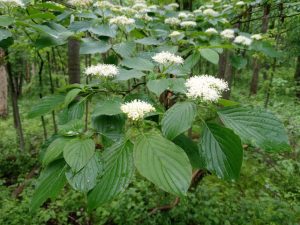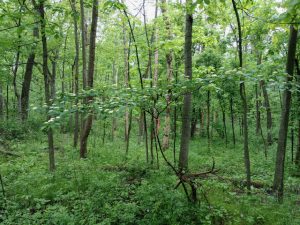What’s that – Alternate Leaf Dogwood!

Spring is a very special time in Wisconsin woodlands. Life is returning to the land. A flush of spring flower rush to grab sunlight and complete their vital business before the canopy closes in for the summer.
Between the still sleeping dome or the treetops and the quite splendor or the spring forest floor is a mid story tree that breaks with its relative anonymity to shout its presence to the world. The alternate leaf dogwood (Cornus alternifolia), also known as the pagoda dogwood or alternate leaf dogwood, erupts with cup sized umbrellas or brilliant white flowers. The clusters of white stand out against the deep green of the dogwood’s leaves making them stand out from across the woodland.
Alternate leaf dogwood trees are small by Wisconsin woodland standards. The tallest of them rarely exceeds 25 feet, with most checking in at closer to 15 feet. They occupy what used to be a relatively vacant mid-story between forest floor dwellers and the majestic canopy. In decades, this niche has become a crowded space filled by invasive shrubs like buckthorn, prickly ash and honeysuckle.
Then and now
In my youth, woodlands grazed by cattle or kept clear by farmers burning, were a much more open place. Searching deep into their recesses was normal. Spotting deer 30, even 50 yards away was common. A riot of spring wildflowers was the much anticipated repayment for enduring yet another brutal Wisconsin winter. Grasses and sedges carpeted the floor on the heals of those pioneering wildflowers; providing the woodland managers easy living in the dappled shade.
Today, Wisconsin dairy cattle live in CAFOs. They graze under steel roofs on corn and soybean feed instead of grass and woodland forbs. The woodlands they abandoned are a massive green wall, supporting few birds and an even smaller array of mammal species. Gray squirrels continue to make a living on the surviving nut trees. But as the oaks and hickory dwindle, even the squirrels are finding it harder to thrive. Escaped landscape plants like barberry and multiflora rose fill in the few spaces left between buckthorn and prickly ash. The poisons exuded by buckthorn and the short nitrogen cycling cause by their rapidly decaying leaves suppress native species further diminishing their numbers.

Yet amid the onslaught of alien and aggressive competitors, a few tough natives battle to maintain a foothold. When we arrived at the Squirrel Farm little more than a year ago, the green was firmly in place. A first pass topped out the seed bearing buckthorn. That was followed by a quick basal bark treatment of as many prickly ash as could be identified in those dense late summer thickets. No initial effort could bring that green wall completely to heal, but it did provide an opportunity to find and protect some of the embattled natives.
There is hope
This spring, we were rewarded with the first views of alternate leaf dogwood trees in the middle distance. More seedlings have sprouted on the woodland floor. They are taking their place along side a growing number of grasses and sedges that will hold the soil while providing seeds and cover for a wider variety of small mammals.
Joining the dogwood this spring are a few maple leaf viburnum, hazelnut and high bush cranberry bushes. The viburnums boast their own brilliant white clusters of flowers, though their need for sun will always restrict them to the forest edges where they can gather sufficient sunlight to meet their needs.
Pioneer spring wildflowers are reasserting themselves, as well. Jack-in-the-pulpet, mayapples and bloodroot are on the upswing. Alongside them are healthy populations of wood anemone and wood geranium bearing a hopeful message for improving woodland health. Still rare, sensitive fern, largeflower bellwort, columbine and showy orchids persist but without any guarantee of a longterm recovery.
It is the alternate leaf dogwood, shouting out their joyous ode to spring across the woodland that makes my heart dance as I take in the new cycle of life in our little Wisconsin woodland.
